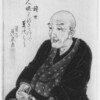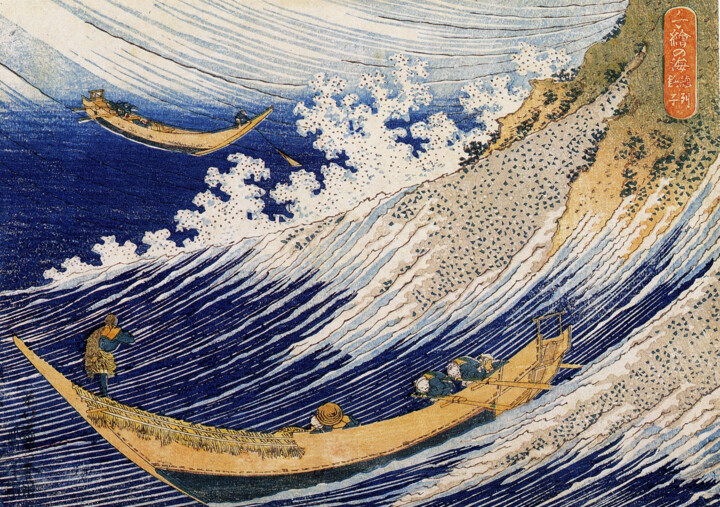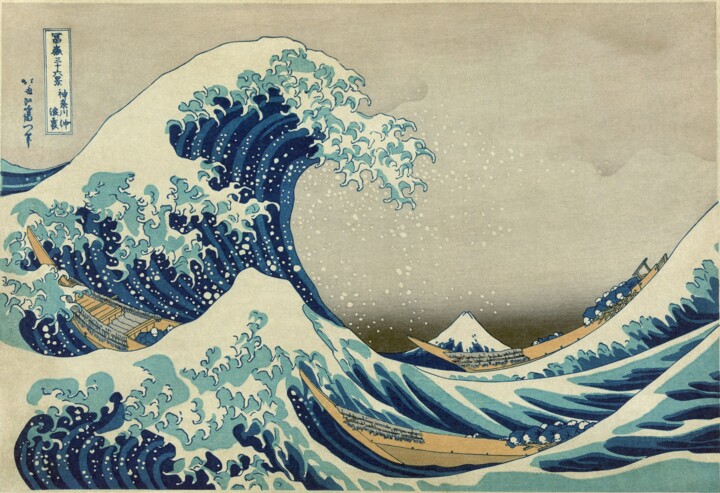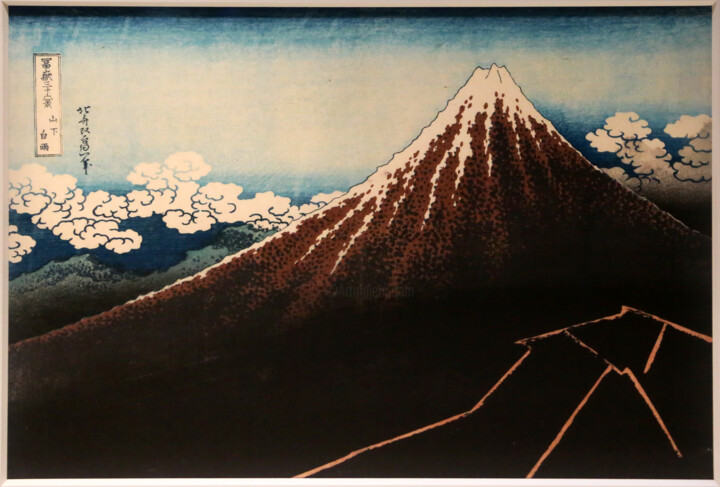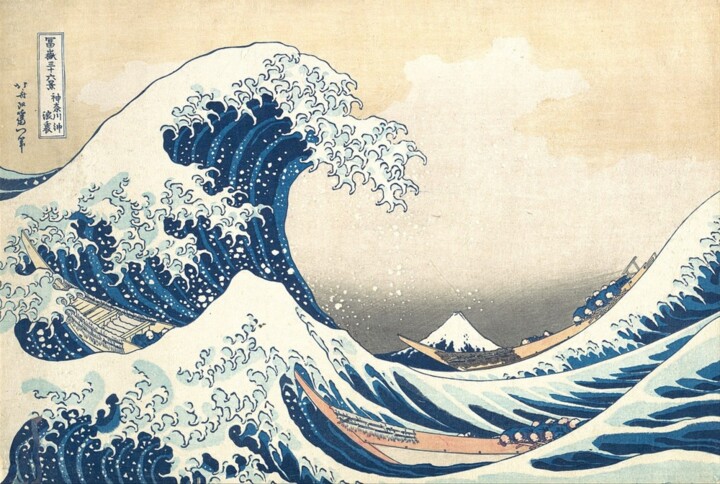 The Great Wave off Kanagawa, by Katsushika Hokusai, 1830-1832
The Great Wave off Kanagawa, by Katsushika Hokusai, 1830-1832
Who is Hokusai?
Katsushika Hokusai (1760-1849) was a Japanese artist famous for his prints, paintings and illustration books. He is often considered one of the most important artists of Edo period Japan and influenced many Western artists with his work. Hokusai is best known for his "Thirty-six Views of Mount Fuji" series of prints, of which "The Great Wave off Kanagawa" is one of the most famous. He also worked on many other projects, including illustration books and murals for temples. Hokusai enjoyed great success throughout his life and continued to work until his death at the age of 89.
Description of the work
The Great Wave off Kanagawa depicts a huge wave rising above a fishing boat in Kanagawa Bay near Tokyo. The artwork is made up of bright, contrasting colors, with tones of blue, white and black blending together to create a striking and almost hypnotic image.
The print is characterized by clean and precise lines, which give the wave a powerful and dynamic look. The boats and mountains in the background create a dramatic and majestic atmosphere, enhancing the visual impact of the wave. The treatment of clouds and waves is particularly impressive, with spiral shapes that add a sense of movement and constant motion.
Hokusai's prints, including "The Great Wave off Kanagawa", are held in many museums and collections around the world. Some of the most important collections include the National Library of France in Paris, the British Museum in London, the Metropolitan Museum of Art in New York, and the Tokyo National Museum in Tokyo. In addition, many art galleries and museums across Japan also display works by Hokusai, including prints from the "Thirty-six Views of Mount Fuji" series.
The style and context of the creation of the work
The Great Wave off Kanagawa was created in the ukiyo-e style, a form of printmaking popular in Japan during the Edo period (1603-1868). The print is made on paper, using the woodcut technique, which involves engraving an image onto a block of wood, which is then inked and pressed onto the paper to create the final image. This technique was commonly used to create large-scale prints for sale, which allowed Hokusai to easily distribute his work.
The Great Wave off Kanagawa was produced at a time when Japan was going through a period of cultural and social transition. Ukiyo-e prints had by then become a popular and inexpensive art form, accessible to all levels of society. Hokusai took advantage of this popularity to create prints that were both aesthetically beautiful and politically provocative.
The print was also influenced by Hokusai's contacts with Western art, especially European prints and perspective techniques. This is particularly noticeable in the depiction of the wave, which uses a form of European perspective to make the wave appear larger than it actually is.
Six fascinating secrets about Hokusai's "The Great Wave off Kanagawa":
The wave is actually a tsunami: Although the print is often interpreted as simply depicting a large wave, some experts believe that the scene actually represents a tsunami. The crashing waves were said to have been inspired by the rocky coast of Kanagawa City, which was often hit by giant waves.
The depiction of Mount Fuji is misleading: Although Mount Fuji is one of the most recognizable features in the print, its position and size have been altered slightly from its actual position. In reality, Mount Fuji would have been smaller and located further out in the landscape.
The print is an example of the "bokashi" technique: To create the color gradation effect in the sky and waves, Hokusai used a technique called "bokashi". This technique involves applying ink gradually to the surface of the printing plate to create a subtle color gradient.
Hokusai used a new type of paper to create the print: For "The Great Wave off Kanagawa", Hokusai used a new type of paper called "washi". This paper, made from mulberry fibers, was stronger and more durable than traditional papers used for prints.
The print has influenced many Western artists: "The Great Wave off Kanagawa" has become one of the most iconic images in Japanese art and has inspired many Western artists, including Vincent van Gogh, Claude Monet and Edgar Degas .
There are modified versions of the print: Over the years, several modified versions of the print have been produced, including color versions and versions with additional details added. Some of these versions were created by Hokusai himself, while others were produced by other artists or printers.
A reverse reading direction
The reading direction of Hokusai's "The Great Wave off Kanagawa" is from left to right. The viewer can observe the powerful wave rising from right to left, while Mount Fuji is visible in the background on the right. Boats, waves and figures are arranged in such a way as to give the impression of movement and chaos, thus creating visual tension in the image. The reading direction is consistent with the way the Japanese traditionally read prints, from right to left. However, in Western cultures, which read from left to right, the work may be perceived as going against the usual reading. This can help to reinforce the sensation of movement and violence of the wave which seems to be reversing the natural order of things.
How to interpret this work?
The interpretation of Hokusai's "The Great Wave off Kanagawa" may vary depending on the viewer and their cultural background. However, here are some possible interpretations:
The wave represents the powerful and indomitable nature. Hokusai portrayed the wave as a force of nature that is capable of overturning boats and bringing destruction. This representation can be interpreted as an allegory of the strength and instability of life.
Mount Fuji represents stability and permanence. While the wave is chaotic and fleeting, Mount Fuji is a symbol of stability and permanence in the image. He is represented as immobile and imperturbable, contrasting with the violence of the wave.
Life and death are represented. Boats trying to ride the wave can be interpreted as representations of human life. The wave, which threatens to overwhelm them, can be interpreted as a representation of death or the end of life.
Japanese culture is represented. The representation of the wave, Mount Fuji and boats can be interpreted as a representation of traditional Japanese culture, where nature and man are closely linked.
The relationship between man and nature is depicted. The image can be interpreted as a representation of the complex relationship between man and nature. Man is depicted as being confronted with a force of nature that overwhelms him, which underlines man's vulnerability to the natural elements.
A specific technique used
The print is made using the traditional Japanese printmaking technique, called ukiyo-e. This technique involves woodcutting and printing multiple colors to create an intricate image. To create the print, Hokusai first drew a sketch on paper, which was then transferred to a block of wood. The parts that were to remain white on the final print were removed from the block, leaving raised parts that were inked. The paper was then pressed onto the woodblock, transferring the ink to the paper to create the image. Hokusai used several blocks of wood to print different colors, creating an image with subtle gradients and shadows. Colors used for "The Great Wave off Kanagawa" print include blue, green, brown, and white.
What blue is used in the work?
 Kajikazawa in Kai Province, Part of the series Thirty-six Views of Mount Fuji, No. 45, 9th Supplementary Plate
Kajikazawa in Kai Province, Part of the series Thirty-six Views of Mount Fuji, No. 45, 9th Supplementary Plate
The blue used is Prussian blue, a color produced from the pigment potassium ferrocyanide. This pigment was introduced to Japan by the Dutch in the 18th century and quickly gained popularity with Japanese artists for its ability to produce deep, rich shades of blue.
The choice of Prussian blue for the print "The Great Wave off Kanagawa" can be interpreted in several ways. On the one hand, the deep blue of the ocean that dominates the image is a key element of the composition and Prussian blue is a natural choice to represent this color. On the other hand, the use of this color can also be seen as a reference to European culture and the influence of Western art on Japanese art at the time Hokusai created this print.
The Wave in popular culture
In music: the cover of the album "Surfing with the Alien" by Joe Satriani takes up the composition of the print with a silhouette of a guitarist in place of the wave. Additionally, the song "The Great Wave" by progressive rock band Yes is also inspired by the work.
In Movies: Hokusai's Wave inspired a scene in the Wachowskis' movie "Matrix Reloaded," where the character of Morpheus battles Matrix agents on a highway twisted by waves. We can also cite the reference to the work in the film "Batman Begins" by Christopher Nolan.
In video games: the wave has appeared in titles such as "Final Fantasy X" and "Samurai Warriors".
In architecture: the headquarters of the Yamaha company in Hamamatsu was designed by the Japanese architect Nikken Sekkei to resemble a stylized wave, in homage to the print of Hokusai.
In comics: Hokusai's print has also inspired comic strip authors such as Tintin and its author Hergé.
In painting and sculpture: Many contemporary artists have used the wave of Hokusai as inspiration for their creations, including British painter David Hockney and American sculptor Alexander Calder.

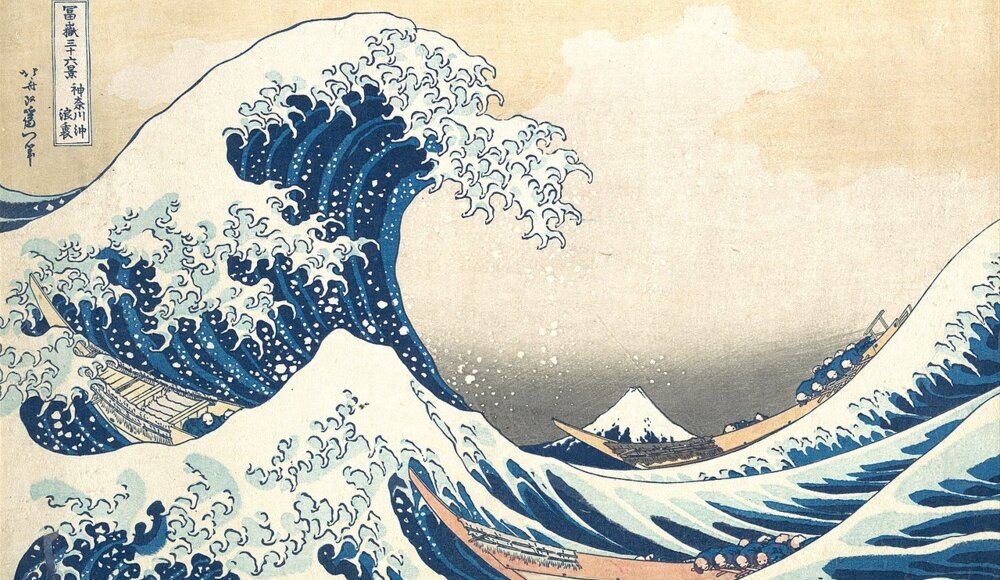
 Selena Mattei
Selena Mattei
